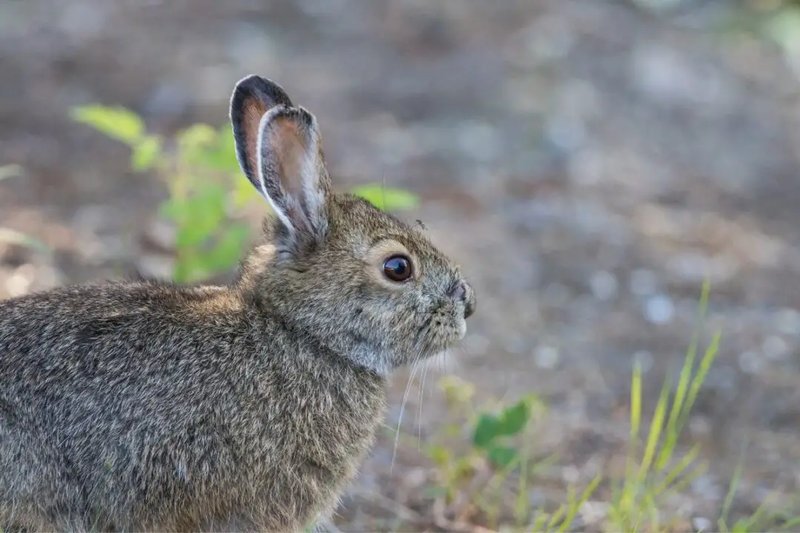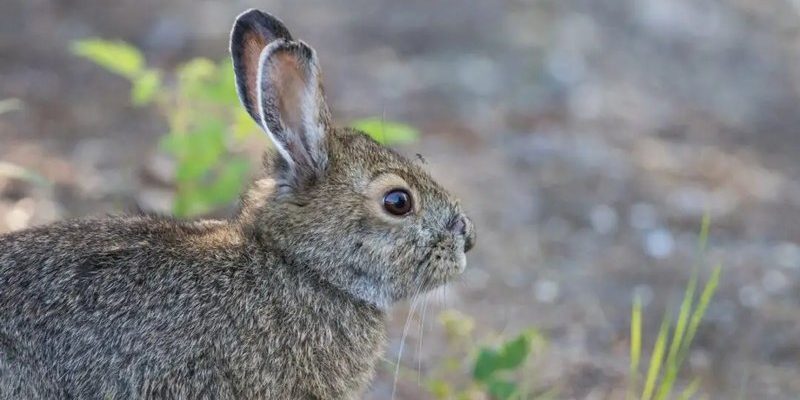
Imagine sitting in a cozy café, a steaming cup of coffee in hand, and having a chat about these animals. It’s fun to compare traits and learn about their lives. Like rabbits, many of these creatures have unique quirks and characteristics that make them special. Just as we can recognize our friends from their smiles, we can identify these animals by what makes them different.
So, are you ready to hop into the world of fluffy friends? Let’s dive right in!
1. Hares
Hares are often mistaken for rabbits, and it’s easy to see why; they’re both part of the same family, Leporidae. However, there are key differences between these two animals. Hares are generally larger than rabbits and have longer ears. If you spot a hare, you might also notice its big hind legs, which help it race faster over long distances.
A simple way to tell them apart is by their young. Baby rabbits, called kits, are born blind and hairless, while baby hares, known as leverets, come into the world fully furred and with their eyes open. This distinction hints at a significant difference in their lifestyles. While rabbits often dig burrows for safety, hares tend to make small nests in grass and rely more on speed to escape predators.
In terms of behavior, hares are more solitary and less social than rabbits. They prefer to spend time alone rather than in groups. If you ever find yourself in a field and see a large, sleek animal darting away, chances are it’s a hare.
2. Pikas
Next up on our list is the pika, a small mammal that looks like a cross between a rabbit and a hamster. Pikas live in the mountainous regions of Asia and North America. They have rounded bodies, short limbs, and, most notably, no visible tail. Picture a tiny ball of fluff, and you’ve got a pika!
Pikas are known for their adorable high-pitched calls, which can be heard echoing through rocky slopes. They’re also quite different from rabbits when it comes to diet. While rabbits munch on grass, pikas are herbivores that prefer foraging for wildflowers and grasses, often storing these plants to eat during the colder months.
Another interesting fact is that pikas are more closely related to hares than they are to rabbits, showing how diverse the Leporidae family can be. If you’re lucky enough to spot one of these critters, you might see it darting around, gathering food, or calling out to its friends.
3. Guinea Pigs
Guinea pigs, or cavies, are another fluffy friend that you might mistake for a rabbit, especially if you only glance at them quickly. These little guys are popular pets, but they have some key differences from rabbits. For one, guinea pigs have more rounded bodies and shorter legs. Their ears are also smaller, giving them a distinct appearance.
Unlike rabbits, guinea pigs are social animals that thrive in groups. In fact, they should ideally be kept with other guinea pigs to keep them happy. They are also vocal creatures, often communicating with squeaks and chirps, which is quite different from a rabbit’s thumping.
Diet-wise, guinea pigs eat a mix of hay, vegetables, and specially formulated pellets, while rabbits often munch on hay, veggies, and leafy greens. If you’re considering adopting one of these pets, remember that their care requirements differ from those of a rabbit, so do your homework!
4. Chinchillas
Chinchillas are often mistaken for rabbits due to their soft, dense fur and playful nature. These small rodents are native to the Andes mountains in South America and are known for their impressive jumping abilities. You might find them hopping around like little clouds!
One major difference is that chinchillas have much larger ears and eyes compared to rabbits. Their fur is also incredibly soft—about 30 times softer than human hair! If you’ve ever had the chance to pet a chinchilla, you’ll know how luxurious their fur feels.
Chinchillas are also nocturnal, which means they’re more active at night. Rabbits, on the other hand, can be crepuscular, being most active during dawn and dusk. While both animals can make great pets, their housing, diet, and social needs vary greatly, so it’s crucial to know what you’re getting into before bringing one home.
5. Ferrets
While ferrets may not seem like an obvious choice, they do share some similarities with rabbits, especially in their mischievous behavior and playful demeanor. These furry little creatures belong to the weasel family and have a more elongated body compared to the round shape of a rabbit.
Ferrets are often seen as “little thieves.” They love to explore, dig, and get into things. This curiosity is something that rabbit owners can relate to, as rabbits can also get into all sorts of trouble! However, ferrets are not as social as rabbits; they require plenty of interaction but often prefer one-on-one time with their humans.
Diet-wise, ferrets are obligate carnivores, which means they need a meat-based diet, unlike rabbits, which are herbivores. If you’re thinking about getting a ferret, you should know they require specific care and environments to thrive, differing significantly from a rabbit’s needs.
6. Playtpus
This might come as a surprise, but the platypus is another animal that can be likened to the rabbit in some aspects of its life. They share a certain cuteness and curious nature, and both animals tend to live in social structures. However, the similarities largely end there!
The platypus is a unique creature known for its distinctive duck-bill and webbed feet, which set it apart from the fluffy little bunny. It’s also a monotreme, meaning it lays eggs instead of giving birth to live young, which is quite unconventional in the mammal world.
While rabbits are primarily land animals, platypuses are semi-aquatic, meaning they spend a lot of their time in the water. Their feeding habits differ significantly as well; whereas rabbits eat grasses and greens, platypuses hunt for insects and larvae underwater. So, while they may share some cuteness, these two creatures are very different!
7. Opossums
Opossums may not look a lot like rabbits at first glance, but they share some notable traits. Both animals have a knack for scavenging and are often found foraging for food. Opossums are nocturnal and travel alone in search of insects, fruits, and even small rodents.
One easy way to tell them apart is their appearance. Opossums generally have a longer snout, a prehensile tail, and a tuft of fur on their ears, while rabbits have shorter snouts and no tail. Plus, opossums have a unique defense mechanism—they “play dead” when threatened, which is quite a spectacle to witness.
They also have a different approach to social living. While rabbits often live in large groups, opossums tend to be solitary creatures. If you spot a critter rummaging through your trash at night, it’s likely an opossum, not a rabbit!
8. Squirrels
Squirrels, with their bushy tails and playful antics, are often seen in parks and backyards, and sometimes they can look quite similar to rabbits from a distance. Both are small mammals known for their agility and ability to live in diverse habitats.
However, there are clear distinctions. Squirrels have a more agile build with long tails for balance, while rabbits are stockier. Furthermore, their diets differ significantly—squirrels are omnivores that eat nuts, seeds, and even some insects, while rabbits are strict herbivores.
Squirrels also exhibit different behavior patterns. They are generally more vocal and engage in a mix of bounding and climbing, while rabbits are more grounded in their movements. So, if you’re watching a furry creature scampering up a tree, you’re likely witnessing a squirrel in action!
9. Hedgehogs
Hedgehogs might seem like an unlikely comparison, yet they share a similar cuteness factor with rabbits. Both animals can be kept as pets and have a penchant for being friendly little companions. Hedgehogs are small, spiky creatures that curl into a ball when threatened, which is quite different from a rabbit’s flight response.
While rabbits are social animals that enjoy the company of their kind, hedgehogs tend to be solitary in the wild. They also have distinct dietary needs, favoring insects and worms over the plant-based diet of rabbits.
If you’ve never seen a hedgehog up close, their unique spines make them stand out. They don’t have the fluffy fur that rabbits do, but their personalities are equally charming. So, while the two animals may share the pet roster, their lives and needs are quite different!
10. Capybaras
Wrapping up our list is the capybara, the largest rodent in the world. Capybaras share some rabbit-like qualities, like their social nature and herbivorous diet, making them fascinating animals to compare. They’re known for their gentle demeanor and often live in groups.
In terms of size, capybaras are vastly different. They can weigh around 100 pounds or more, dwarfing even the largest rabbits. When you see one, it’s hard to mistake it for a rabbit due to its massive stature and unique appearance. They have a more elongated face and a chunky body, making them quite different from our fluffy friends!
While they enjoy the company of others and can be quite affectionate with humans, they require more space due to their size and social habits. If you ever find yourself by a body of water in South America, keep an eye out for a capybara lounging by the shore!
In conclusion, while rabbits are undeniably adorable and beloved animals, there are many other creatures out there that share similarities. From hares to capybaras, each animal has its unique traits that make them special. Whether you’re a pet owner or simply someone who enjoys learning about animals, knowing the differences between these similar creatures can deepen your appreciation for nature. Next time you spot a fluffy friend, remember to look a little closer—you might just discover something new!

